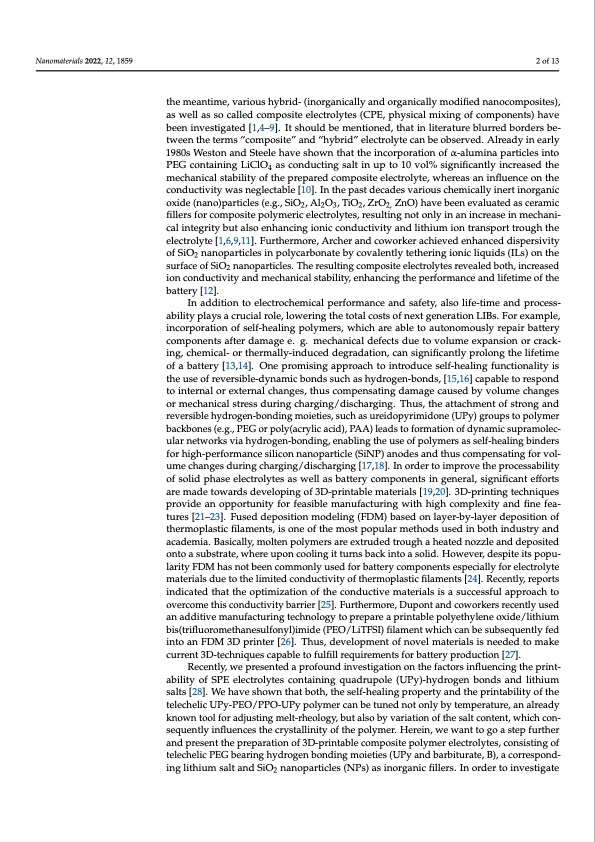
PDF Publication Title:
Text from PDF Page: 002
Nanomaterials 2022, 12, 1859 2 of 13 the meantime, various hybrid- (inorganically and organically modified nanocomposites), as well as so called composite electrolytes (CPE, physical mixing of components) have been investigated [1,4–9]. It should be mentioned, that in literature blurred borders be- tween the terms “composite” and “hybrid” electrolyte can be observed. Already in early 1980s Weston and Steele have shown that the incorporation of α-alumina particles into PEG containing LiClO4 as conducting salt in up to 10 vol% significantly increased the mechanical stability of the prepared composite electrolyte, whereas an influence on the conductivity was neglectable [10]. In the past decades various chemically inert inorganic oxide (nano)particles (e.g., SiO2, Al2O3, TiO2, ZrO2, ZnO) have been evaluated as ceramic fillers for composite polymeric electrolytes, resulting not only in an increase in mechani- cal integrity but also enhancing ionic conductivity and lithium ion transport trough the electrolyte [1,6,9,11]. Furthermore, Archer and coworker achieved enhanced dispersivity of SiO2 nanoparticles in polycarbonate by covalently tethering ionic liquids (ILs) on the surface of SiO2 nanoparticles. The resulting composite electrolytes revealed both, increased ion conductivity and mechanical stability, enhancing the performance and lifetime of the battery [12]. In addition to electrochemical performance and safety, also life-time and process- ability plays a crucial role, lowering the total costs of next generation LIBs. For example, incorporation of self-healing polymers, which are able to autonomously repair battery components after damage e. g. mechanical defects due to volume expansion or crack- ing, chemical- or thermally-induced degradation, can significantly prolong the lifetime of a battery [13,14]. One promising approach to introduce self-healing functionality is the use of reversible-dynamic bonds such as hydrogen-bonds, [15,16] capable to respond to internal or external changes, thus compensating damage caused by volume changes or mechanical stress during charging/discharging. Thus, the attachment of strong and reversible hydrogen-bonding moieties, such as ureidopyrimidone (UPy) groups to polymer backbones (e.g., PEG or poly(acrylic acid), PAA) leads to formation of dynamic supramolec- ular networks via hydrogen-bonding, enabling the use of polymers as self-healing binders for high-performance silicon nanoparticle (SiNP) anodes and thus compensating for vol- ume changes during charging/discharging [17,18]. In order to improve the processability of solid phase electrolytes as well as battery components in general, significant efforts are made towards developing of 3D-printable materials [19,20]. 3D-printing techniques provide an opportunity for feasible manufacturing with high complexity and fine fea- tures [21–23]. Fused deposition modeling (FDM) based on layer-by-layer deposition of thermoplastic filaments, is one of the most popular methods used in both industry and academia. Basically, molten polymers are extruded trough a heated nozzle and deposited onto a substrate, where upon cooling it turns back into a solid. However, despite its popu- larity FDM has not been commonly used for battery components especially for electrolyte materials due to the limited conductivity of thermoplastic filaments [24]. Recently, reports indicated that the optimization of the conductive materials is a successful approach to overcome this conductivity barrier [25]. Furthermore, Dupont and coworkers recently used an additive manufacturing technology to prepare a printable polyethylene oxide/lithium bis(trifluoromethanesulfonyl)imide (PEO/LiTFSI) filament which can be subsequently fed into an FDM 3D printer [26]. Thus, development of novel materials is needed to make current 3D-techniques capable to fulfill requirements for battery production [27]. Recently, we presented a profound investigation on the factors influencing the print- ability of SPE electrolytes containing quadrupole (UPy)-hydrogen bonds and lithium salts [28]. We have shown that both, the self-healing property and the printability of the telechelic UPy-PEO/PPO-UPy polymer can be tuned not only by temperature, an already known tool for adjusting melt-rheology, but also by variation of the salt content, which con- sequently influences the crystallinity of the polymer. Herein, we want to go a step further and present the preparation of 3D-printable composite polymer electrolytes, consisting of telechelic PEG bearing hydrogen bonding moieties (UPy and barbiturate, B), a correspond- ing lithium salt and SiO2 nanoparticles (NPs) as inorganic fillers. In order to investigatePDF Image | 3D Printable Composite Polymer Electrolytes

PDF Search Title:
3D Printable Composite Polymer ElectrolytesOriginal File Name Searched:
nanomaterials-12-01859-v2.pdfDIY PDF Search: Google It | Yahoo | Bing
Product and Development Focus for Salgenx
Redox Flow Battery Technology: With the advent of the new USA tax credits for producing and selling batteries ($35/kW) we are focussing on a simple flow battery using shipping containers as the modular electrolyte storage units with tax credits up to $140,000 per system. Our main focus is on the salt battery. This battery can be used for both thermal and electrical storage applications. We call it the Cogeneration Battery or Cogen Battery. One project is converting salt (brine) based water conditioners to simultaneously produce power. In addition, there are many opportunities to extract Lithium from brine (salt lakes, groundwater, and producer water).Salt water or brine are huge sources for lithium. Most of the worlds lithium is acquired from a brine source. It's even in seawater in a low concentration. Brine is also a byproduct of huge powerplants, which can now use that as an electrolyte and a huge flow battery (which allows storage at the source).We welcome any business and equipment inquiries, as well as licensing our flow battery manufacturing.| CONTACT TEL: 608-238-6001 Email: greg@salgenx.com | RSS | AMP |